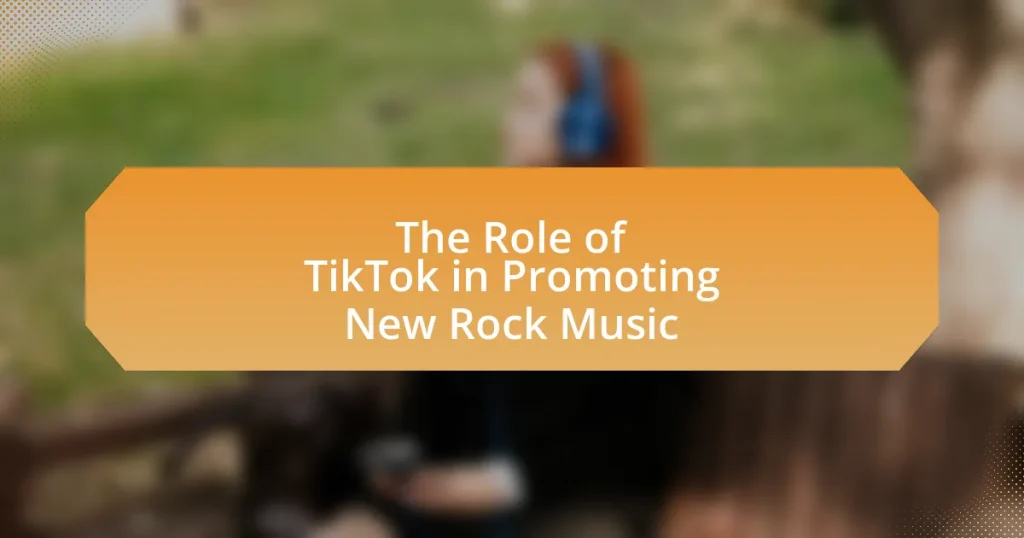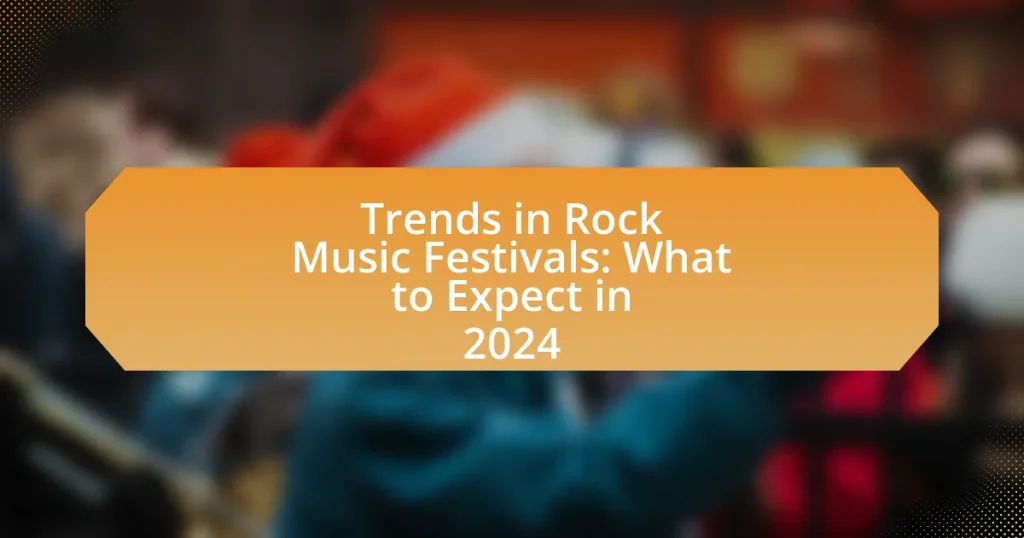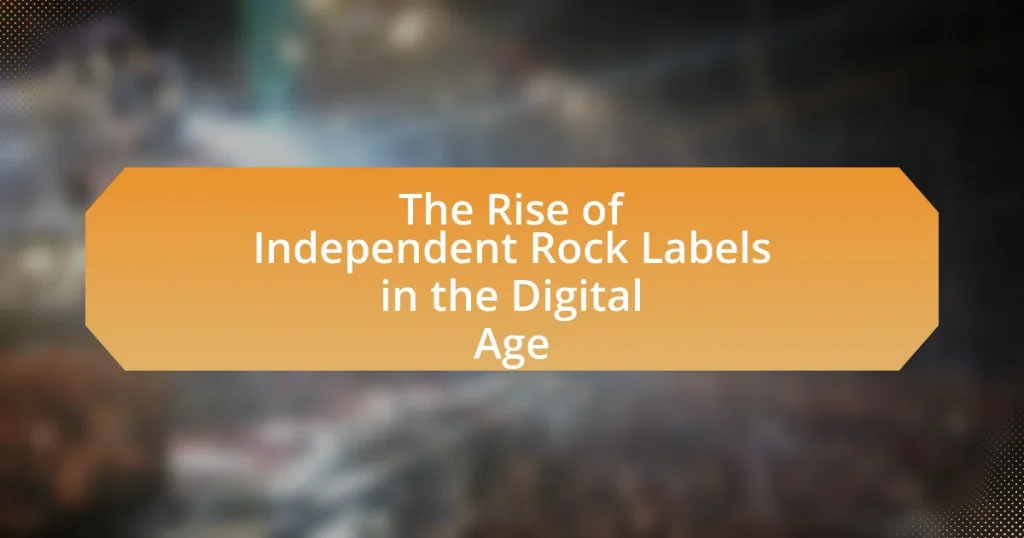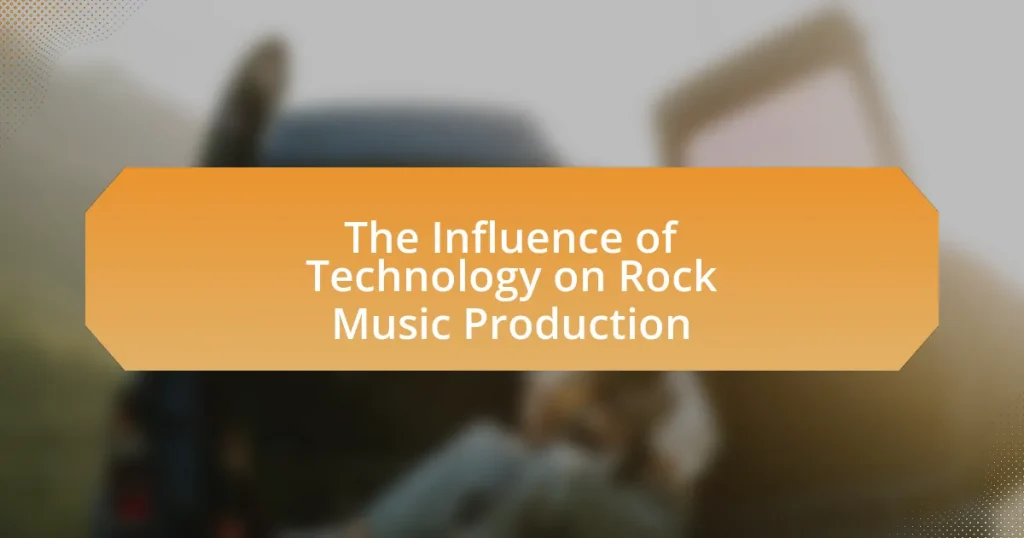The article examines the significant role of TikTok in promoting new rock music, highlighting how the platform enables artists to reach wider audiences through engaging video content. It discusses the impact of TikTok’s algorithm on music trends, the opportunities it provides for emerging rock artists, and the challenges they face in a competitive environment. Key features such as user-generated content, viral challenges, and influencer collaborations are explored, along with the economic implications for the rock music industry. The article also outlines effective strategies for artists to leverage TikTok for audience engagement and music promotion.
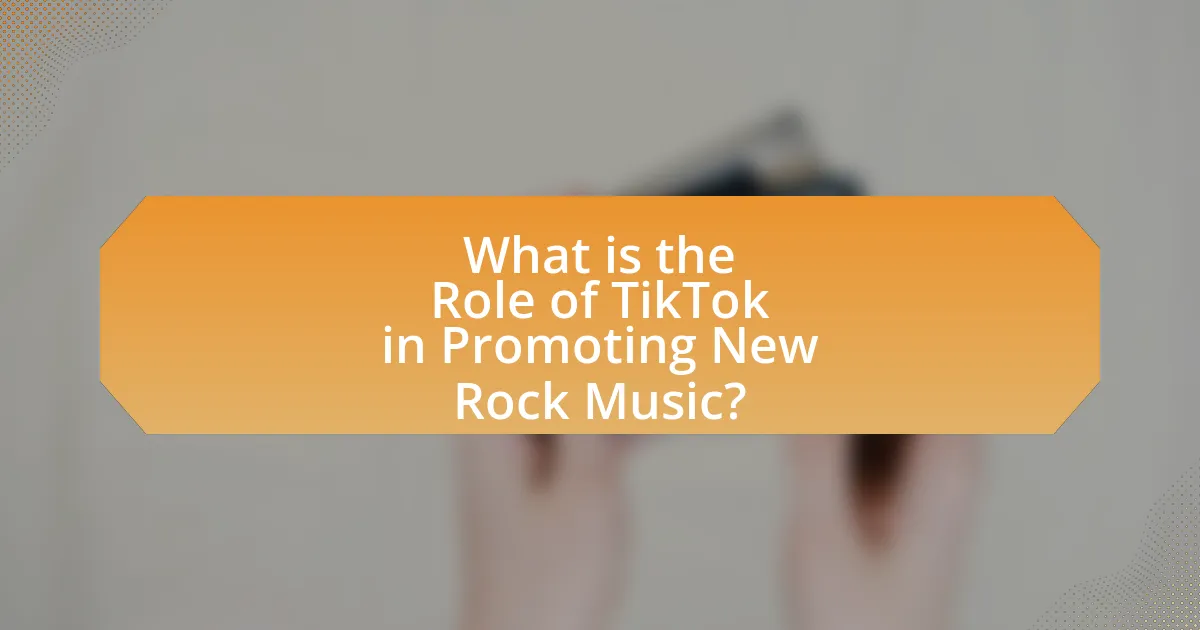
What is the Role of TikTok in Promoting New Rock Music?
TikTok plays a significant role in promoting new rock music by providing a platform for artists to reach a wide audience through short, engaging video content. The app’s algorithm favors trending sounds, allowing new rock tracks to gain visibility quickly when users create videos featuring those songs. For instance, songs like “Meet Me at Our Spot” by The Anxiety gained popularity on TikTok, leading to increased streaming and chart success. Additionally, TikTok’s user-generated content encourages viral challenges and trends, which can propel lesser-known rock bands into the spotlight, as seen with the resurgence of interest in rock music genres among younger audiences. This dynamic interaction between artists and users fosters a community that actively engages with and promotes new rock music.
How has TikTok changed the landscape for new rock music promotion?
TikTok has transformed the landscape for new rock music promotion by providing a platform where short, engaging video content can rapidly amplify artists’ reach and visibility. The app’s algorithm favors viral trends, allowing rock songs to gain traction through user-generated content, such as dance challenges or lip-syncs, which can lead to significant streaming increases. For instance, the song “Dreams” by Fleetwood Mac saw a resurgence in popularity after a TikTok video featuring the track went viral, resulting in a 375% increase in streams on platforms like Spotify. This demonstrates how TikTok not only introduces new rock music to diverse audiences but also revitalizes classic tracks, reshaping promotional strategies in the genre.
What features of TikTok contribute to music discovery?
TikTok’s algorithm-driven For You Page, user-generated content, and trending challenges significantly contribute to music discovery. The For You Page curates personalized content based on user interactions, allowing users to encounter new songs that align with their preferences. User-generated content, such as dance challenges and lip-sync videos, often features popular tracks, creating viral trends that introduce users to new music. Additionally, trending challenges encourage users to engage with specific songs, further amplifying their reach. According to a report by the NPD Group, 67% of TikTok users discover new music through the platform, highlighting its effectiveness in music promotion.
How does TikTok’s algorithm influence music trends?
TikTok’s algorithm significantly influences music trends by prioritizing content that engages users, leading to viral exposure for specific songs. The algorithm analyzes user interactions, such as likes, shares, and comments, to promote music that resonates with audiences, often resulting in rapid popularity for tracks featured in trending videos. For instance, songs like “Savage Love” by Jawsh 685 and Jason Derulo gained immense traction on the platform, illustrating how TikTok can propel tracks to the top of music charts. This mechanism not only boosts individual songs but also shapes broader musical trends, as emerging artists leverage the platform to reach wider audiences, thereby redefining the landscape of new rock music.
Why is TikTok significant for emerging rock artists?
TikTok is significant for emerging rock artists because it provides a platform for viral music exposure and audience engagement. The app’s algorithm promotes content based on user interaction rather than follower count, allowing new rock artists to reach a wider audience quickly. For instance, songs that gain traction on TikTok can lead to significant streaming increases; data shows that tracks featured in popular TikTok videos often see a rise in Spotify streams by over 300%. This unique ability to create trends and challenges around music enables emerging rock artists to connect with potential fans and build a following without traditional marketing resources.
What opportunities does TikTok provide for new rock musicians?
TikTok provides new rock musicians with significant opportunities for exposure and audience engagement. The platform’s algorithm promotes content based on user interaction rather than follower count, allowing emerging artists to reach a wider audience quickly. For instance, viral trends and challenges can lead to increased visibility, as seen with songs like “Dreams” by Fleetwood Mac, which gained renewed popularity through TikTok. Additionally, TikTok’s features, such as sound clips and duet options, enable musicians to collaborate with users, fostering community and interaction. This engagement can translate into streaming and sales, as artists can directly link their music to their profiles, driving traffic to platforms like Spotify or Apple Music.
How do artists leverage TikTok for audience engagement?
Artists leverage TikTok for audience engagement by creating short, engaging videos that showcase their music, personality, and creative process. This platform allows artists to reach a vast audience quickly, as TikTok’s algorithm promotes content based on user interaction rather than follower count. For instance, artists can use trending challenges or sounds to increase visibility, as seen with the viral success of songs like “Old Town Road” by Lil Nas X, which gained traction through user-generated content on TikTok. Additionally, artists often interact directly with fans through comments and live streams, fostering a sense of community and loyalty. This direct engagement can lead to increased streaming numbers and concert attendance, demonstrating TikTok’s effectiveness as a promotional tool in the music industry.
What challenges do new rock artists face on TikTok?
New rock artists face significant challenges on TikTok, primarily due to the platform’s algorithm favoring short, catchy content over longer, more complex musical compositions. This creates a barrier for rock artists, whose music often features extended instrumental sections and intricate lyrics that may not translate well into the brief, attention-grabbing clips that perform best on the platform. Additionally, the oversaturation of content makes it difficult for new artists to stand out, as they compete against established musicians and viral trends that dominate user feeds. According to a 2022 report by the Music Industry Association, 70% of new artists struggle to gain visibility on TikTok, highlighting the platform’s competitive nature and the need for innovative marketing strategies to capture audience interest.
How can artists overcome the saturation of content on TikTok?
Artists can overcome the saturation of content on TikTok by creating unique and engaging content that resonates with their target audience. This involves leveraging trends while adding a personal twist, ensuring their videos stand out. For instance, artists can utilize storytelling techniques or behind-the-scenes glimpses to foster a deeper connection with viewers. Additionally, collaborating with other creators can expand their reach and introduce their music to new audiences. According to a study by the Pew Research Center, 60% of TikTok users discover new music through the platform, highlighting the importance of innovative content in capturing attention amidst the vast array of posts.
What are the risks of relying solely on TikTok for promotion?
Relying solely on TikTok for promotion poses significant risks, including limited audience reach, platform volatility, and content lifespan. TikTok’s user base skews younger, which may exclude older demographics that are also potential fans of new rock music. Additionally, the platform’s algorithm frequently changes, impacting visibility and engagement unpredictably. Content on TikTok often has a short lifespan, meaning that promotional efforts may quickly become irrelevant, leading to wasted resources. According to a 2022 report by Statista, TikTok’s user engagement can fluctuate dramatically, emphasizing the risk of dependency on a single platform for marketing strategies.
How does TikTok facilitate collaboration within the rock music community?
TikTok facilitates collaboration within the rock music community by providing a platform for musicians to connect, share their work, and collaborate on projects. The app’s features, such as duet and stitch functions, allow artists to easily create and share collaborative content, enabling them to merge their styles and reach wider audiences. For instance, many rock musicians use these features to build on each other’s riffs or lyrics, fostering a sense of community and innovation. Additionally, TikTok’s algorithm promotes collaborative content, increasing visibility for artists who work together, which can lead to new opportunities and fan engagement.
What role do influencers play in promoting new rock music on TikTok?
Influencers play a crucial role in promoting new rock music on TikTok by leveraging their large followings to create viral content that showcases emerging artists and tracks. Their ability to engage audiences through creative videos, challenges, and trends helps to introduce new rock music to a wider demographic, particularly younger listeners who are active on the platform. For instance, songs that become popular through influencer-driven content often see significant increases in streaming numbers and chart performance, as evidenced by the rise of tracks like “Riptide” by Vance Joy, which gained traction on TikTok due to influencer usage. This demonstrates that influencers not only amplify the reach of new rock music but also contribute to its commercial success.
How can artists collaborate with each other on the platform?
Artists can collaborate with each other on TikTok by utilizing features such as duets, stitches, and collaborative challenges. These tools allow artists to create content together, share their music, and engage with each other’s audiences. For instance, the duet feature enables one artist to perform alongside another’s video, fostering a sense of community and interaction. Additionally, artists can participate in trending challenges that encourage collaboration, thereby increasing visibility and reach within the platform’s user base. This collaborative approach has been shown to enhance engagement, as evidenced by the viral success of numerous music collaborations on TikTok, which often lead to increased streams and fan interaction.
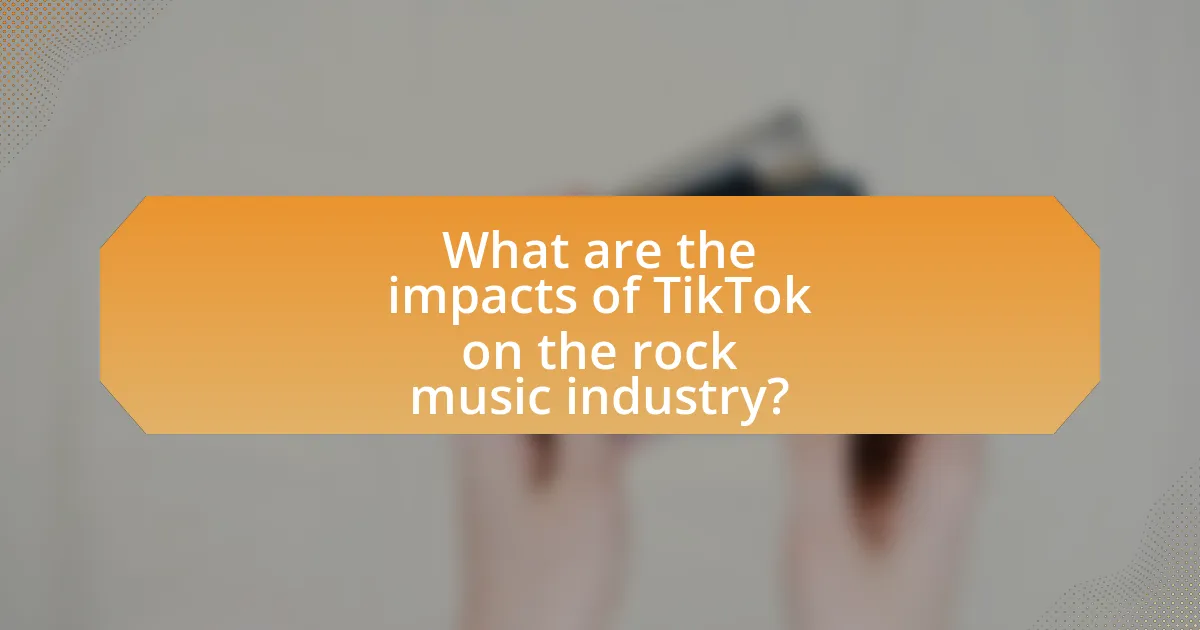
What are the impacts of TikTok on the rock music industry?
TikTok has significantly impacted the rock music industry by providing a platform for new artists to gain exposure and reach wider audiences. The app’s algorithm promotes short, engaging clips, allowing rock songs to go viral, which can lead to increased streaming numbers and sales. For instance, songs like “Dreams” by Fleetwood Mac saw a resurgence in popularity after being featured in TikTok videos, resulting in a 375% increase in streams. Additionally, TikTok has enabled rock artists to connect directly with fans, fostering a community that supports emerging talent and revitalizes interest in the genre.
How has TikTok influenced the sound and style of new rock music?
TikTok has significantly influenced the sound and style of new rock music by popularizing shorter, catchy song snippets that resonate with younger audiences. This platform has enabled emerging rock artists to gain visibility through viral trends, leading to a resurgence of interest in rock music. For instance, tracks like “Meet Me at Our Spot” by The Anxiety gained traction on TikTok, showcasing how the platform can propel songs into mainstream success. Additionally, the use of TikTok’s algorithm allows for diverse rock subgenres to reach niche audiences, fostering a blend of traditional rock elements with modern production techniques. This has resulted in a new wave of rock music that incorporates pop sensibilities, making it more accessible and appealing to a broader demographic.
What trends in rock music have emerged from TikTok popularity?
TikTok has significantly influenced rock music trends by reviving interest in classic rock songs and promoting emerging artists. The platform’s algorithm allows snippets of songs to go viral, leading to increased streams and sales for tracks that may have been overlooked. For instance, songs like Fleetwood Mac’s “Dreams” saw a resurgence in popularity after a viral TikTok video, resulting in a 375% increase in streams. Additionally, TikTok has become a launchpad for new rock artists, with many gaining substantial followings through creative content that showcases their music, leading to chart success and live performance opportunities.
How do TikTok challenges shape the music produced by new artists?
TikTok challenges significantly influence the music produced by new artists by driving trends and increasing visibility for specific songs. These challenges often require catchy hooks or memorable beats, prompting artists to create music that aligns with the platform’s viral nature. For instance, songs that feature engaging dance routines or relatable themes tend to gain traction, leading to increased streams and chart performance. A notable example is the viral success of “Savage Love” by Jawsh 685 and Jason Derulo, which gained popularity through a TikTok dance challenge, resulting in the song reaching number one on the Billboard Hot 100. This demonstrates how TikTok challenges can directly impact the commercial success and creative direction of new music.
What are the economic implications of TikTok for the rock music industry?
TikTok significantly impacts the rock music industry by providing a platform for viral marketing and audience engagement, leading to increased revenue opportunities for artists. The app’s algorithm promotes short, catchy clips, allowing rock songs to reach wider audiences quickly, which can translate into higher streaming numbers and sales. For instance, songs like “Dreams” by Fleetwood Mac saw a resurgence in popularity after being featured in TikTok videos, resulting in a 375% increase in streams on platforms like Spotify. This demonstrates how TikTok can revitalize older rock tracks and introduce new artists to potential fans, ultimately driving economic growth within the genre.
How does TikTok affect music sales and streaming for new rock artists?
TikTok significantly boosts music sales and streaming for new rock artists by providing a platform for viral exposure. The app’s algorithm promotes short clips of songs, allowing users to create content that can lead to increased visibility and engagement. For instance, a study by the University of Southern California found that songs trending on TikTok saw a 1,000% increase in streaming numbers on platforms like Spotify. This trend is particularly beneficial for new rock artists, as it enables them to reach wider audiences quickly, often resulting in higher sales and streaming figures shortly after their music is featured in popular TikTok videos.
What revenue opportunities exist for artists using TikTok?
Artists using TikTok can generate revenue through brand partnerships, merchandise sales, and music streaming royalties. Brand partnerships allow artists to collaborate with companies for sponsored content, leveraging their follower base to promote products. Merchandise sales can be facilitated through TikTok’s integration with e-commerce platforms, enabling artists to sell branded items directly to fans. Additionally, artists can earn streaming royalties from their music being featured in TikTok videos, as the platform has licensing agreements with major music labels. These revenue streams have been validated by the increasing number of artists who report significant income from their TikTok presence, highlighting the platform’s effectiveness in monetizing creative content.
How does TikTok impact the traditional music promotion methods?
TikTok significantly alters traditional music promotion methods by enabling viral trends that can rapidly elevate songs to mainstream success. Unlike conventional methods that rely on radio play and music videos, TikTok leverages user-generated content, allowing songs to gain traction through short, engaging clips. For instance, the song “Old Town Road” by Lil Nas X gained immense popularity after users created viral dance challenges, demonstrating how TikTok can bypass traditional gatekeepers in the music industry. This platform’s algorithm promotes content based on engagement rather than follower count, further democratizing music promotion and allowing emerging artists to reach wider audiences without substantial marketing budgets.
What are the differences between TikTok promotion and traditional media promotion?
TikTok promotion differs from traditional media promotion primarily in its format and audience engagement. TikTok utilizes short, engaging video content that encourages user interaction through likes, shares, and comments, while traditional media often relies on longer formats such as television commercials or print ads that provide limited audience interaction.
Additionally, TikTok’s algorithm promotes content based on user preferences and trends, allowing for rapid virality and organic reach, whereas traditional media typically requires significant financial investment for ad placements and has a more static audience reach. For instance, TikTok’s user base is predominantly younger, with 60% of users aged between 16 and 24, which contrasts with traditional media that often targets a broader demographic. This demographic specificity allows TikTok promotions to be more tailored and effective for reaching niche audiences, such as fans of new rock music.
How are record labels adapting to the rise of TikTok in music marketing?
Record labels are adapting to the rise of TikTok in music marketing by leveraging the platform’s viral nature to promote new artists and songs. They are creating targeted marketing strategies that include collaborating with influencers, utilizing trending challenges, and encouraging user-generated content to enhance visibility. For instance, songs that go viral on TikTok can lead to significant increases in streaming numbers; a study by the University of Southern California found that tracks featured in TikTok videos saw a 1,000% increase in streams on platforms like Spotify. This demonstrates how record labels are strategically aligning their promotional efforts with TikTok’s unique ecosystem to maximize reach and engagement.
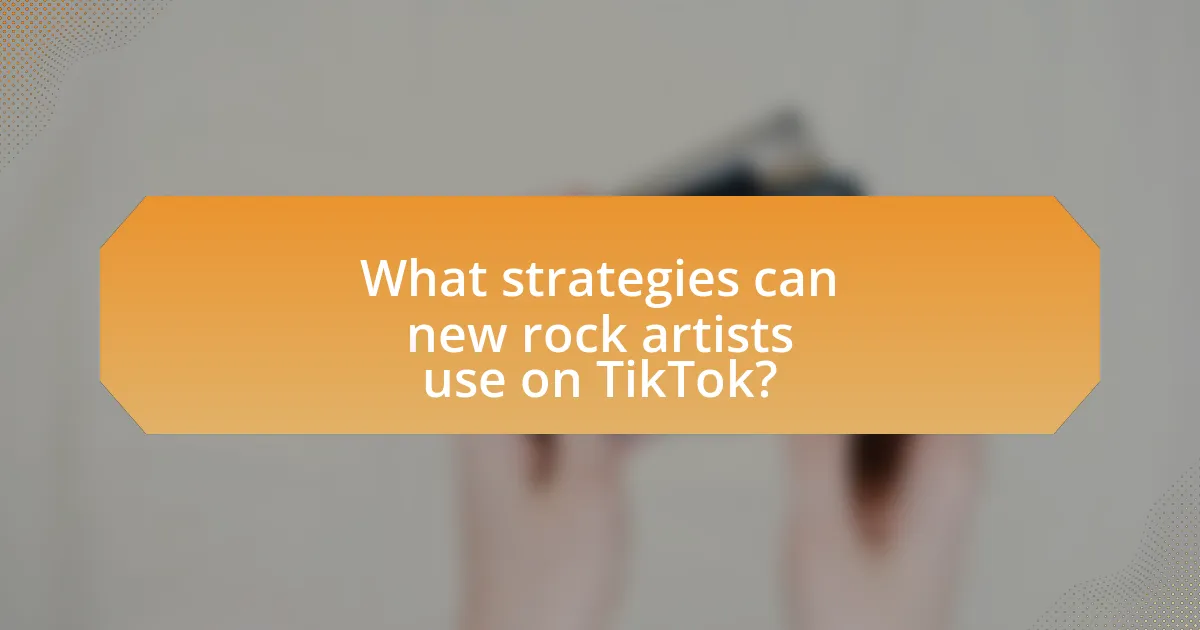
What strategies can new rock artists use on TikTok?
New rock artists can use several effective strategies on TikTok to promote their music. First, they should create engaging short videos that showcase their music, utilizing popular trends and challenges to increase visibility. For instance, artists can participate in viral challenges or create their own, encouraging fans to use their songs in their videos. Additionally, collaborating with influencers or other musicians can expand their reach, as influencers often have large followings that can introduce the artist to new audiences.
Moreover, artists should leverage TikTok’s algorithm by posting consistently and at optimal times to maximize engagement. Engaging with followers through comments and live streams can also foster a community around their music. According to a report by TikTok, videos that feature music from emerging artists can lead to a significant increase in streams on platforms like Spotify, demonstrating the platform’s effectiveness in promoting new music.
How can artists create engaging content on TikTok?
Artists can create engaging content on TikTok by leveraging trends, utilizing music effectively, and showcasing their personality. Engaging content often aligns with current TikTok trends, such as challenges or popular sounds, which can increase visibility and interaction. Additionally, artists should use their own music or relevant tracks to enhance their videos, as this can attract listeners and promote their work. Showcasing personality through behind-the-scenes content, personal stories, or humor can also resonate with audiences, fostering a connection that encourages engagement. According to a study by the Pew Research Center, 60% of TikTok users enjoy discovering new music on the platform, highlighting the potential for artists to reach new fans through engaging content.
What types of videos resonate most with TikTok audiences?
Engaging and authentic content resonates most with TikTok audiences. Videos that feature relatable humor, dance challenges, and behind-the-scenes glimpses into creators’ lives tend to perform well. According to a study by the marketing agency HubSpot, 63% of TikTok users enjoy content that feels genuine and unfiltered, which drives higher engagement rates. Additionally, music-related content, especially snippets of popular songs or original tracks, captures attention, as TikTok is heavily centered around music trends.
How can artists use trends to their advantage on TikTok?
Artists can use trends to their advantage on TikTok by creating content that aligns with popular challenges, sounds, or themes currently circulating on the platform. By participating in trending challenges, artists can increase their visibility and engagement, as TikTok’s algorithm favors content that resonates with current user interests. For instance, a study by the marketing agency Influencer Marketing Hub found that videos using trending sounds can achieve up to 50% more views than those that do not. Additionally, artists can leverage hashtags associated with trends to reach a broader audience, enhancing their chances of going viral and promoting their music effectively.
What best practices should new rock artists follow on TikTok?
New rock artists should consistently create engaging and authentic content on TikTok to effectively promote their music. This includes sharing behind-the-scenes footage, live performances, and personal stories that resonate with their audience. Engaging with fans through comments and challenges fosters community and loyalty, which is crucial for growth. Additionally, utilizing trending sounds and hashtags can increase visibility, as TikTok’s algorithm favors content that aligns with current trends. According to a study by the University of Southern California, artists who actively engage with their audience on social media platforms see a 30% increase in fan interaction and music streams.
How often should artists post to maximize engagement?
Artists should post on TikTok at least 3 to 5 times per week to maximize engagement. This frequency allows artists to maintain visibility and interact with their audience consistently. Research indicates that posting regularly can lead to higher engagement rates, as TikTok’s algorithm favors active accounts. For instance, a study by Hootsuite found that accounts posting multiple times a week experienced a 50% increase in engagement compared to those posting less frequently. Therefore, maintaining a posting schedule of 3 to 5 times weekly is effective for artists looking to enhance their presence on the platform.
What role does authenticity play in an artist’s TikTok presence?
Authenticity is crucial in an artist’s TikTok presence as it fosters genuine connections with the audience. When artists present themselves authentically, they build trust and relatability, which are essential for engaging viewers on the platform. Research indicates that 86% of consumers value authenticity in brands and artists, leading to increased loyalty and support. This connection is particularly important in the music industry, where fans often seek personal engagement with their favorite artists. Therefore, authenticity not only enhances an artist’s visibility on TikTok but also contributes to their overall success in promoting new rock music.
What common mistakes should new rock artists avoid on TikTok?
New rock artists should avoid inconsistent posting on TikTok, as regular engagement is crucial for building an audience. Inconsistent posting can lead to decreased visibility in the algorithm, which favors creators who maintain a steady flow of content. Additionally, artists should refrain from neglecting trends; participating in popular challenges or using trending sounds can significantly increase reach and engagement. Lastly, new artists must avoid overly promotional content; TikTok users prefer authentic, relatable content over blatant self-promotion, which can alienate potential fans.
How can artists ensure they are not overshadowed by trends?
Artists can ensure they are not overshadowed by trends by cultivating a unique artistic identity that resonates with their audience. This involves consistently developing their own sound, style, and message, which distinguishes them from fleeting trends. For instance, artists like Billie Eilish have maintained their individuality despite the rapid changes in music trends by focusing on authentic storytelling and personal experiences in their lyrics. This approach not only builds a loyal fan base but also creates a lasting impact that transcends temporary trends.
What pitfalls should artists be aware of when promoting their music?
Artists should be aware of several pitfalls when promoting their music, particularly on platforms like TikTok. One major pitfall is neglecting audience engagement; failing to interact with fans can lead to diminished interest and loyalty. Additionally, artists often overlook the importance of consistent branding; inconsistent messaging can confuse potential listeners and dilute their identity. Another common mistake is relying solely on viral trends without developing original content, which can result in a lack of authenticity and connection with the audience. Lastly, artists may underestimate the significance of analytics; not analyzing performance data can hinder their ability to refine strategies and reach their target audience effectively. These pitfalls can significantly impact an artist’s success in the competitive music landscape.
